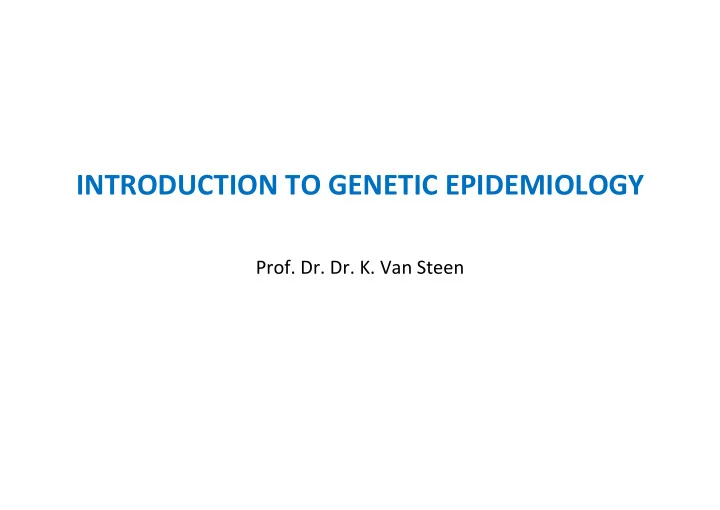

INTRODUCTION TO GENETIC EPIDEMIOLOGY Prof. Dr. Dr. K. Van Steen
Introduction to Genetic Epidemiology CHAPTER 2: Basic population genetics BASIC POPULATION GENETICS 1 What is means and doesn’t mean 1.a Introduction Goals and aims 1.b The three domains of population genetics Theoretical, empirical, experimental 2 How does evolution take place? 2.a Darwin 2.b Evolution K Van Steen
Introduction to Genetic Epidemiology CHAPTER 2: Basic population genetics 3 Distributions of genotypes in human populations 3.a Random mating 3.b Hardy-Weinberg equilibrium 3.c Allelic association 3.d Linkage disequilibrium 4 Natural selection revisited 5 Inbreeding 6 Fitness K Van Steen
Introduction to Genetic Epidemiology CHAPTER 2: Basic population genetics 1 What it means and doesn’t mean Main references: Ritland K. Population genetics (course slides) K Van Steen
Introduction to Genetic Epidemiology CHAPTER 2: Basic population genetics 1.a Introduction Frequency at the heart of population genetics K Van Steen
Introduction to Genetic Epidemiology CHAPTER 2: Basic population genetics The essence of population genetics A gene by itself is a constant entity (but perhaps harbors mutation) Alternative forms of a gene (allele) can exist at certain frequencies in a population These frequencies can change (via genetic drift, selection mutation) Resulting in adaptation and evolution There are two major facets: - Describing the pattern of genetic diversity - Investigating the processes that generate this diversity K Van Steen
Introduction to Genetic Epidemiology CHAPTER 2: Basic population genetics What is it useful for? Breeding - Plant and animal breeding - Pesticide and herbicide resistance - Effects of release of GM organisms People - Forensic analysis (DNA fingerprinting) - Identification of genes for complex human traits - Genetic counseling - Study of human evolution and human origin Ecology and evolution - Inferring evolutionary processes - Preservation of endangered species K Van Steen
Introduction to Genetic Epidemiology CHAPTER 2: Basic population genetics 1.b The three domains of population genetics Theoretical Empirical Experimental K Van Steen
Introduction to Genetic Epidemiology CHAPTER 2: Basic population genetics Theoretical population genetics • General theoretical models predict evolution of gene frequencies and other things • Highly dependent upon assumptions • May or may not be realistic • Mathematically satisfying K Van Steen
Introduction to Genetic Epidemiology CHAPTER 2: Basic population genetics K Van Steen
Introduction to Genetic Epidemiology CHAPTER 2: Basic population genetics K Van Steen
Introduction to Genetic Epidemiology CHAPTER 2: Basic population genetics Empirical population genetics Apply statistical models to real data to infer underlying processes Again, adequate sampling is necessary to achieve statistical power Empirical population genetics is often emphasized due to the enormous volumes of genetic data that is out there. K Van Steen
Introduction to Genetic Epidemiology CHAPTER 2: Basic population genetics Experimental population genetics in practice Test hypotheses in population genetics using controlled experiments Design such that alternative outcomes possible, some of which can reject hypothesis Need controls, replicates and adequate sample size Usually restricted to model organisms - Drosophila, Neurospora, some crop plants K Van Steen
Introduction to Genetic Epidemiology CHAPTER 2: Basic population genetics K Van Steen
Introduction to Genetic Epidemiology CHAPTER 2: Basic population genetics 2 How does evolution take place? Main references: URLs: http://www.biosci.ohio-state.edu/~pfuerst/course K Van Steen
Introduction to Genetic Epidemiology CHAPTER 2: Basic population genetics 2.a Darwin ’s model in population genetics Introduction The modern evolutionary synthesis is a combination of Darwin's theory of the evolution of species by natural selection, Mendel's theory of genetics as the basis for biological inheritance, and mathematical population genetics. Put together by dozens of scientists throughout the 1930s and 1940s, Darwinian population genetics is our best model of the process that incrementally created all life on earth, evolution and natural selection. K Van Steen
Introduction to Genetic Epidemiology CHAPTER 2: Basic population genetics Charles Darwin (1803-1873) Natural selection is considered to In the 19th century, a man called be the biggest factor resulting in Charles Darwin , a biologist from the diversity of species and their England, set off on the ship HMS genomes. Beagle to investigate species in exotic places (e.g., Galapagos islands). After spending time on the islands, he soon developed a theory that would contradict the creation of man and imply that all species derived from common ancestors through a process called natural selection . K Van Steen
Introduction to Genetic Epidemiology CHAPTER 2: Basic population genetics Darwin’s principles One of the prime motives for all species is to reproduce and survive, passing on the genetic information of the species from generation to generation. When species do this they tend to produce more offspring than the environment can support. The lack of resources to nourish these individuals places pressure on the size of the species population , and the lack of resources means increased competition and as a consequence, some organisms will not survive. The organisms who die as a consequence of this competition were not totally random, Darwin found that those organisms more suited to their environment were more likely to survive. This resulted in the well known phrase survival of the fittest , where the organisms most suited to their environment had more chance of survival if the species falls upon hard times. Those organisms who are better suited to their environment exhibit desirable characteristics, which is a consequence of their genome being more suitable to begin with. K Van Steen
Introduction to Genetic Epidemiology CHAPTER 2: Basic population genetics Darwin’s tree of life This 'weeding out' of less suited organisms and the reward of survival to those better suited led Darwin to deduce that organisms had evolved over time, where the most desirable characteristics of a species are favored and those organisms who exhibit them survive to pass their genes on. As a consequence of this, a changing environment would mean different characteristics would be favorable in a changing environment. Darwin believed that organisms had 'evolved' to suit their environments, and occupy an ecological niche where they would be best suited to their environment and therefore have the best chance of survival. (http://www.biology-online.org/2/10_natural_selection.htm) K Van Steen
Recommend
More recommend